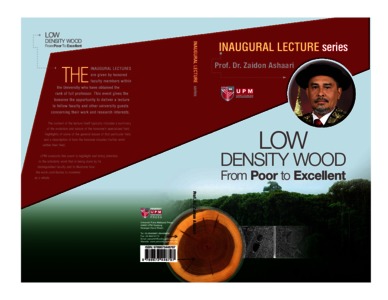Citation
Ashaari, Zaidon
(2017)
Low density wood: from poor to excellent.
[Inaugural Lecture]
Abstract
One of the greatest attributes of wood is that it is a renewable resource. It has been used for thousands of years as both fuel and construction material. The raw materials used in Malaysia’s wood-based industries comprise mainly hardwood extracted from natural and plantation forests. Hardwood timbers are classified into three categories, heavy hardwoods (HHW), medium hardwoods (MHW) and light hardwoods (LHW). The classification of the three hardwood categories is based largely on the average density of the timbers.
The timber industry is one of the major contributors to the Malaysian economy, contributing up to 2.7 per cent of the country’s export earnings. The timber and timber products category commodity exports was the third most important after palm oil and rubber in 2014. The export of timber and timber products in 2015 was valued at RM21.14 billion and the government expects the industry to contribute RM53 billion to the country’s export earnings by 2020. In order to ensure that the projected goal is achieved, an adequate and sustained supply of wood raw material is important for further development of the timber industry. Further, the timber industry needs to innovate and re-invent itself to stay competitive. It is expected that the future growth of the industry will be through higher productivity, innovation and technological breakthroughs. Innovation, in this context, refers to the successful exploitation of new ideas and designs that result in tangible products and services. Meanwhile, technology involves the application of knowledge, equipment, machines and processes, in translating innovations into newer, more sophisticated products for commercial gain. Hence, in order for the timber industry to remain relevant, it has to adopt new state-of-the-art technologies to overcome production bottlenecks and produce newer and more sophisticated products.
The wood-based products industry in Malaysia is expected to face the problem of inadequate supply of raw materials to sustain the growth of the industry in the future. Supply of raw materials from natural and plantation forests may not suffice and the industry will thus have to seek alternative raw materials to augment the diminishing supply of traditional commercial timbers. Through innovation and R&D activities, the inferior properties of low density wood, OPW and bamboo, which are normally used for traditional purposes, can be enhanced and become a source of alternative raw materials for the wood-based industries.
This lecture series is aimed at reviewing the importance of tropical wood, its classification, strength, durability and sustainability to meet the future demands of the wood-based industries. It further aims to highlight the research works carried out at the Faculty of Forestry, Universiti Putra Malaysia, on enhancing the properties of low density wood or underutilised timber species, particularly mahang (Macarang spp.), sesenduk (Endospermum diadenum), jelutong (Dyera costulata) and oil palm wood (Elaeis guineensis), so that they can be further utilised and made into higher value-added products.
Download File
![[img]](http://psasir.upm.edu.my/66859/1.hassmallThumbnailVersion/20170725181150212_Prof_Zaidon_Low_Density_Wood_from_poor_to_excellent.pdf)  Preview |
|
Text
20170725181150212_Prof_Zaidon_Low_Density_Wood_from_poor_to_excellent.pdf
Download (7MB)
| Preview
|
|
Additional Metadata
Actions (login required)
 |
View Item |

